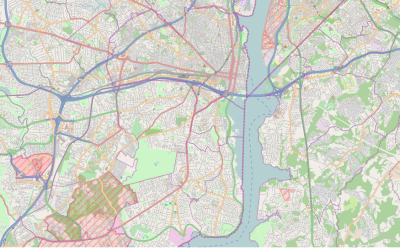
A | B | C | D | E | F | G | H | CH | I | J | K | L | M | N | O | P | Q | R | S | T | U | V | W | X | Y | Z | 0 | 1 | 2 | 3 | 4 | 5 | 6 | 7 | 8 | 9
Arlington County | |
|---|---|
 Arlington's Rosslyn neighborhood seen from across the Potomac River from Washington Harbour in Georgetown | |
 Location within the U.S. state of Virginia | |
 Virginia's location within the U.S. | |
| Coordinates: 38°52′49″N 77°06′30″W / 38.880278°N 77.108333°W | |
| Country | |
| State | |
| Founded | February 27, 1801 |
| Named for | Arlington House |
| Area | |
| • Total | 26 sq mi (70 km2) |
| • Land | 26 sq mi (70 km2) |
| • Water | 0.2 sq mi (0.5 km2) 0.4% |
| Population (2020) | |
| • Total | 238,643 |
| • Density | 9,200/sq mi (3,500/km2) |
| Time zone | UTC−5 (Eastern) |
| • Summer (DST) | UTC−4 (EDT) |
| Congressional district | 8th |
| Website | www |
Arlington County, or simply Arlington, is a county in the U.S. state of Virginia.[1] The county is located in Northern Virginia on the southwestern bank of the Potomac River directly across from Washington, D.C., the national capital.
Arlington County is coextensive with the U.S. Census Bureau's census-designated place of Arlington. Arlington County is the eighth-most populous county in the Washington metropolitan area with a population of 238,643 as of the 2020 census.[2] If Arlington County were incorporated as a city, it would rank as the third-most populous city in the state. With a land area of 26 square miles (67 km2), Arlington County is the geographically smallest self-governing county in the nation.
Arlington County is home to the Pentagon, the world's second-largest office structure, which houses the headquarters of the U.S. Department of Defense. Other notable locations are DARPA, the Drug Enforcement Administration's headquarters, Reagan National Airport, and Arlington National Cemetery. Colleges and universities in the county include Marymount University and George Mason University's Antonin Scalia Law School, School of Business, the Carter School for Peace and Conflict Resolution, and Schar School of Policy and Government. Graduate programs, research, and non-traditional student education centers affiliated with the University of Virginia and Virginia Tech are also located in the county.
Corporations based in the county include the co-headquarters of Amazon, several consulting firms, and the global headquarters of Boeing, Raytheon Technologies, and BAE Systems Platforms & Services.[3]
History
Colonial Virginia
Present-day Arlington County was part of Fairfax County in the Colony of Virginia during the colonial era. Land grants from the British Crown were awarded to prominent Englishmen in exchange for political favors and efforts as part of the county's early development. One of the grantees was Thomas Fairfax for whom both Fairfax County and the City of Fairfax are named. The county's name was derived from Henry Bennet, the Earl of Arlington, which was a plantation along the Potomac River, and Arlington House, the family residence on that property. George Washington Parke Custis, grandson of First Lady Martha Washington, acquired the land in 1802.[4] The estate was later passed down to Mary Anna Custis Lee, wife of Robert E. Lee, a Confederate general during the American Civil War, and then later seized by the U.S. federal government in a tax sale.[5] The property later became the Arlington National Cemetery.
Residence Act
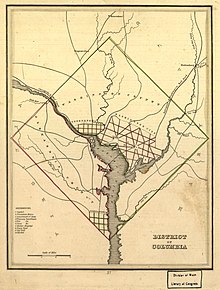
Present-day Arlington County and most of present-day Alexandria were ceded to the new federal government by Virginia. On July 16, 1790, the Congress passed the Residence Act, which authorized the relocation of the capital from Philadelphia to a location to be selected on the Potomac River by U.S. President George Washington. The Residence Act originally only allowed the President to select a location in Maryland as far east as the Anacostia River. President Washington, however, shifted the federal territory's borders to the southeast in order to include the existing town of Alexandria.
In 1791, Congress, at Washington's request, amended the Residence Act to approve the new site, including the territory ceded by Virginia.[6] The amendment to the Residence Act prohibited the "erection of the public buildings otherwise than on the Maryland side of the River Potomac."[7]
The initial shape of the federal district was a square, measuring 10 miles (16 km) on each side, totaling 100 square miles (260 km2). In 1791 and 1792, Andrew Ellicott and several assistants placed boundary stones at every mile point. Fourteen of these markers were in Virginia, and many of the stones are still standing.[8]
When Congress arrived in the new capital from Philadelphia, one of their first acts was to pass the Organic Act of 1801, officially organizing the District of Columbia and placing the entire federal territory, including present-day Washington, D.C., Georgetown, and Alexandria under the exclusive control of Congress. The territory in the District was organized into two counties: the County of Washington to the east of the Potomac River and the County of Alexandria to the west. It included almost all of present-day Arlington County and part of present-day Alexandria.[9]
The Act established the borders of the area that eventually became Arlington, but the citizens in Washington, D.C., were no longer considered residents of Maryland or Virginia, which represented the end of their federal representation in Congress.[10]
Retrocession

Prior to retrocession, residents of Alexandria County expected the proximity of the federal capital to result in higher land prices and the growth of regional commerce. The county instead found itself struggling to compete with the Chesapeake and Ohio Canal in Georgetown, which was farther inland and on the northern side of the Potomac River next to Washington, D.C.[11] Members of Congress from other areas of Virginia used their influence to prohibit funding for projects, including the Alexandria Canal, which would have increased competition with their home districts. Congress also prohibited the federal government from establishing any offices in Alexandria, which made the county less important to the functioning of the national government.[12]
Alexandria was a center for the slave trade; Franklin and Armfield Office in Alexandria was once an office used in slave trading. Rumors circulated that abolitionists in Congress were attempting to end slavery in the District, an act that, at the time, would have further depressed Alexandria's slavery-based economy.[13] At the same time, an active abolitionist movement arose in Virginia that created a division on the question of slavery in the Virginia General Assembly. Pro-slavery Virginians recognized that if Alexandria were returned to Virginia, it could provide two new representatives who favored slavery in the state legislature. Some time after retrocession, during the American Civil War, this division led to the formation of West Virginia as a state, which comprised what then 51 counties in the northwest part of the state that favored abolitionism.[14]
Largely as a result of the economic neglect by Congress, divisions over slavery, and the lack of voting rights for the residents of the District, a movement grew to return Alexandria to Virginia from the District of Columbia. From 1840 to 1846, Alexandrians petitioned Congress and the Virginia legislature to approve such a transfer, known as retrocession. On February 3, 1846, the Virginia General Assembly agreed to accept the retrocession of Alexandria if Congress approved. Following additional lobbying by Alexandrians, Congress passed legislation on July 9, 1846, to return all the District's territory south of the Potomac River back to Virginia, pursuant to a referendum, and President James K. Polk signed the legislation the next day. A referendum on retrocession was held on September 1 and 2, 1846, and the voters in Alexandria voted in favor of the retrocession by a margin of 734 to 116, while those in the rest of Alexandria County voted against retrocession 106 to 29. Pursuant to the referendum, President Polk issued a proclamation of transfer on September 7, 1846. However, the Virginia legislature did not immediately accept the retrocession offer. Virginia legislators were concerned that Alexandria County residents had not been properly included in the retrocession proceedings. After months of debate, on March 13, 1847, the Virginia General Assembly voted to formally accept the retrocession legislation.[12]
In 1852, the Virginia legislature voted to incorporate a portion of Alexandria County as the City of Alexandria, which until then had been administered only as an unincorporated town within the political boundaries of Alexandria County.[15]
Civil War

During the American Civil War, Virginia seceded from the Union following a statewide referendum on May 23, 1861; the voters from Alexandria County approved secession by a vote of 958–48. The vote indicates the degree to which its only town, Alexandria, was pro-secession and pro-Confederate. Rural county residents outside Alexandria were largely Union loyalists and voted against secession.[16]
For the duration of the Civil War, the Confederacy claimed the whole of antebellum Virginia, including the more staunchly Union-supporting northwestern counties that eventually broke away and were later admitted to the Union in 1863 as West Virginia. However, the Confederacy never fully controlled all of present-day Northern Virginia. In 1862, the U.S. Congress passed a law that required that obligated owners of property in districts where active Confederate insurrections were occurring to pay their real estate taxes in person.[17]
In 1864, during the Civil War, the U.S. federal government confiscated the Abingdon estate, which was located on and near the present Ronald Reagan Washington National Airport, when its owner failed to pay the estate's property tax in person because he was serving in the Confederate States Army.[17] The government then sold the property at auction, and the purchaser leased the property to a third party.[17]
In 1865, after the Civil War ended, the Abingdon estate's heir, Alexander Hunter, filed a federal lawsuit to recover the property. James A. Garfield, a Republican member of the U.S. House of Representatives who was a brigadier general in the Union Army during the Civil War and later became the 20th President of the United States, was an attorney on Hunter's legal team.[17] In 1870, the U.S. Supreme Court found that the U.S. federal government had illegally confiscated the property and ordered that it be returned to Hunter.[17]
The property included the former residence of Confederate General Robert E. Lee's family at and around Arlington House, which had been subjected to an appraisal of $26,810, on which a real estate tax of $92.07 was assessed. Likely fearing an encounter with Union officials, Lee's wife, Mary Anna Custis Lee, the owner of the property, chose not pay the tax in person. She instead sent an agent on her behalf, but Union officials refused to accept it.[18][19] As a result of the 1862 law, the U.S. federal government confiscated the property, and transformed it into a military cemetery.[18]
After the Civil War ended and his parents died, George Washington Custis Lee, the Lees' eldest son, initiated a federal legal action in an attempt to recover the property.[18] In December 1882, the U.S. Supreme Court found that the U.S. federal government illegally confiscated the property without due process, and the property was returned to Custis Lee.[18][19] In 1883, the U.S. Congress purchased the property from Lee for its fair market value of $150,000, whereupon the property became a military reservation and eventually Arlington National Cemetery. Although Arlington House is within the National Cemetery, the National Park Service presently administers the House and its grounds as a memorial to Robert E. Lee.[18]
Confederate incursions from Falls Church, Minor's Hill and Upton's Hill, then securely in Confederate hands, occurred as far east as the present-day Ballston. On August 17, 1861, 600 Confederate soldiers engaged the 23rd New York Infantry Regiment near Ballston, killing a Union Army soldier. Later that month, on August 27, another large incursion of 600 to 800 Confederate soldiers clashed with Union soldiers at Ball's Crossroads, Hall's Hill, and at the present-day border between the Falls Church and Arlington. A number of soldiers on both sides were killed. However, the territory in present-day Arlington never fell under Confederate control and was not attacked.[20]
Separation from Alexandria

In 1870, the City of Alexandria was legally separated from Alexandria County by an amendment to the Virginia Constitution that made all Virginia incorporated cities, but not incorporated towns independent of the counties with which they had previously been a part. Confusion between the city and the county of Alexandria having the same name led to a movement to rename Alexandria County.
In 1896, an electric trolley line was built from Washington, D.C. through Ballston; Northern Virginia trolleys were a significant factor in the county's growth. In 1920, the trolley was named Arlington County, named after Arlington House, the home of the American Civil War Confederate general Robert E. Lee later seized by the Union in a tax sale, is located on the grounds of Arlington National Cemetery.
20th century



In 1900, Blacks were more than a third of Arlington County's population. Over the course of the century, the Black population dwindled. Neighborhoods in Arlington set up racial covenants and forbade Blacks from owning or domiciling property.[21][22] In 1938, Arlington banned row houses, a type of housing that was heavily used by Black residents. By October 1942, not a single rental unit was available in the county.[23] In the 1940s, the federal government evicted black neighborhoods to build the Pentagon and make room for highway construction.[21]
In 1908, Potomac was incorporated as a town in Alexandria County, and was annexed by Alexandria in 1930.
In 1920, the Virginia legislature renamed the area Arlington County to avoid confusion with the City of Alexandria which had become an independent city in 1870 under the new Virginia Constitution adopted after the Civil War.
In the 1930s, Hoover Field was established on the present site of the Pentagon; in that decade, Buckingham, Colonial Village, and other apartment communities also opened. World War II brought a boom to the county, but one that could not be met by new construction due to rationing imposed by the war effort.
In October 1949, the University of Virginia in Charlottesville created an extension center in the county named Northern Virginia University Center of the University of Virginia. This campus was subsequently renamed University College, then the Northern Virginia Branch of the University of Virginia, then George Mason College of the University of Virginia, and finally to its present name, George Mason University.[24] The Henry G. Shirley Highway, also known as Interstate 395, was constructed during World War II, along with adjacent developments such as Shirlington, Fairlington, and Parkfairfax.
In February 1959, Arlington Public Schools desegregated racially at Stratford Junior High School, which is now Dorothy Hamm Middle School, with the admission of black pupils Donald Deskins, Michael Jones, Lance Newman, and Gloria Thompson. The U.S. Supreme Court's ruling in 1954, Brown v. Board of Education of Topeka, Kansas had struck down the previous ruling on racial segregation Plessy v. Ferguson that held that facilities could be racially "separate but equal". Brown v. Board of Education ruled that "racially separate educational facilities were inherently unequal". The elected Arlington County School Board presumed that the state would defer to localities and in January 1956 announced plans to integrate Arlington schools.
The state responded by suspending the county's right to an elected school board. The Arlington County Board, the ruling body for the county, appointed segregationists to the school board and blocked plans for desegregation. Lawyers for the local chapter of the National Association for the Advancement of Colored People (NAACP) filed suit on behalf of a group of parents of both white and black students to end segregation. Black pupils were still denied admission to white schools, but the lawsuit went before the U.S. District Court, which ruled that Arlington schools were to be desegregated by the 1958–59 academic year. In January 1959 both the U.S. District Court and the Virginia Supreme Court had ruled against Virginia's massive resistance movement, which opposed racial integration.[25] The Arlington County Central Library's collections include written materials as well as accounts in its Oral History Project of the desegregation struggle in the county.[26]
During the 1960s, Arlington experienced challenges related to a large influx of newcomers during the 1950s. M.T. Broyhill & Sons Corporation was at the forefront of building the new communities for these newcomers, which would lead to the election of Joel Broyhill as the representative of Virginia's 10th congressional district for 11 terms.[27] The old commercial districts did not have ample off-street parking and many shoppers were taking their business to new commercial centers, such as Parkington and Seven Corners. Suburbs further out in Virginia and Maryland were expanding, and Arlington's main commercial center in Clarendon was declining, similar to what happened in other downtown centers. With the growth of these other suburbs, some planners and politicians pushed for highway expansion. The Federal Aid Highway Act of 1956 would have enabled that expansion in Arlington. The administrator of the National Capital Transportation Agency, economist C. Darwin Stolzenbach, saw the benefits of rapid transit for the region and oversaw plans for a below ground rapid transit system, now the Washington Metro, which included two lines in Arlington. Initial plans called for what became the Orange Line to parallel I-66, which would have mainly benefited Fairfax County.
Arlington County officials called for the stations in Arlington to be placed along the decaying commercial corridor between Rosslyn and Ballston that included Clarendon. A new regional transportation planning entity was formed, the Washington Metropolitan Transit Authority. Arlington officials renewed their push for a route that benefited the commercial corridor along Wilson Boulevard, which prevailed. There were neighborhood concerns that there would be high-density development along the corridor that would disrupt the character of old neighborhoods.
With the population in the county declining, political leaders saw economic development as a long-range benefit. Citizen input and county planners came up with a workable compromise, with some limits on development. The two lines in Arlington were inaugurated in 1977. The Orange Line's creation was more problematic than the Blue Line's. The Blue Line served the Pentagon and National Airport and boosted the commercial development of Crystal City and Pentagon City. Property values along the Metro lines increased significantly for both residential and commercial property. The ensuing gentrification caused the mostly working and lower middle class white Southern residents to either be priced out of rent or in some cases sell their homes. This permanently changed the character of the city, and ultimately resulted in the virtual eradication of this group over the coming 30 years, being replaced with an increasing presence of a white-collar transplant population mostly of Northern stock.
While a population of white-collar government transplant workers had always been present in the county, particularly in its far northern areas and in Lyon Village, the 1980s, 1990s and 2000s saw the complete dominance of this group over the majority of Arlington's residential neighborhoods, and mostly economically eliminated the former working-class residents of areas such as Cherrydale, Lyon Park, Rosslyn, Virginia Square, Claremont, and Arlington Forest, among other neighborhoods. The transformation of Clarendon is particularly striking. This neighborhood, a downtown shopping area, fell into decay. It became home to a vibrant Vietnamese business community in the 1970s and 1980s known as Little Saigon. It has now been significantly gentrified. Its Vietnamese population is now barely visible, except for several holdout businesses. Arlington's careful planning for the Metro has transformed the county and has become a model revitalization for older suburbs.[28][29]
In 1965, after years of negotiations, Arlington swapped some land in the south end with Alexandria, though less than originally planned. The land was located along King Street and Four Mile Run. The exchange allowed the two jurisdictions to straighten out the boundary and helped highway and sewer projects to go forward. It moved into Arlington several acres of land to the south of the old county line that had not been a part of the District of Columbia.[30]
21st century
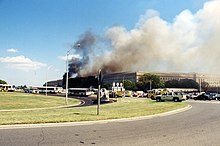

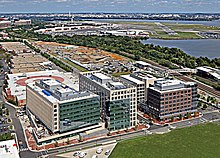
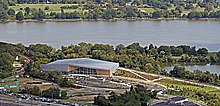

On September 11, 2001, five al-Qaeda hijackers deliberately crashed American Airlines Flight 77 into the Pentagon, killing 115 Pentagon employees and 10 contractors in the building, and all 53 passengers, six crew members, and five hijackers on board the aircraft. The coordinated attacks were the most deadly terrorist attack in world history.[31]
In 2009, Turnberry Tower, located in the Rosslyn neighborhood, was completed. At the time of completion, the Turnberry Tower was the tallest residential building in the Washington metropolitan area.[32][33]
In 2017, Nestlé USA chose 1812 N Moore in Rosslyn as their U.S. headquarters.[34]
In 2018, Amazon.com, Inc. announced that it would build its co-headquarters in the Crystal City neighborhood, anchoring a broader area of Arlington and Alexandria that was simultaneously rebranded as National Landing.[35]
By 2020, single-family detached homes accounted for nearly 75% of zoned property in Arlington.[21]
Geography

Arlington County is located in Northern Virginia and is surrounded by Fairfax County and Falls Church to the west, the city of Alexandria to the southeast, and the national capital of Washington, D.C. to the northeast across the Potomac River, which forms the county's northern border. Minor's Hill and Upton's Hill represent the county's western borders.
According to the U.S. Census Bureau, the county has a total area of 26.1 square miles (67.6 km2), 26.0 square miles (67.3 km2) of which is land and 0.1 square miles (0.3 km2) (0.4%) of which is water.[36] It is the smallest county by area in Virginia and is the smallest self-governing county in the United States.[37] About 4.6 square miles (11.9 km2) (17.6%) of the county is federal property. The county courthouse and most government offices are located in the Courthouse neighborhood.
Since the late 20th century, the county government has pursued a development strategy of concentrating much of its new development near transit facilities, such as Metrorail stations and the high-volume bus lines of Columbia Pike.[38] Within the transit areas, the government has a policy of encouraging mixed-use and pedestrian- and transit-oriented development.[39] Some of these "urban village" communities include:
- Aurora Highlands
- Ballston
- Barcroft
- Bluemont
- Broyhill Heights
- Claremont
- Clarendon
- Courthouse
- Crystal City
- Glencarlyn
- Greenbrier
- High View Park (formerly Halls Hill)
- Lyon Village
- Palisades
- Pentagon City
- Penrose
- Radnor - Fort Myer Heights
- Rosslyn
- Shirlington
- Virginia Square
- Waycroft-Woodlawn (formerly Woodlawn Park)
- Westover
- Williamsburg Circle
In 2002, Arlington received the EPA's National Award for Smart Growth Achievement for "Overall Excellence in Smart Growth."[40] In 2005, the County implemented an affordable housing ordinance that requires most developers to contribute significant affordable housing resources, either in units or through a cash contribution, in order to obtain the highest allowable amounts of increased building density in new development projects, most of which are planned near Metrorail station areas.[41]
A number of the county's residential neighborhoods and larger garden-style apartment complexes are listed in the National Register of Historic Places and/or designated under the County government's zoning ordinance as local historic preservation districts.[42][43] These include Arlington Village, Arlington Forest, Ashton Heights, Buckingham, Cherrydale, Claremont, Colonial Village, Fairlington, Lyon Park, Lyon Village, Maywood, Nauck, Penrose, Waverly Hills and Westover.[44][45] Many of Arlington County's neighborhoods participate in the Arlington County government's Neighborhood Conservation Program (NCP).[46] Each of these neighborhoods has a Neighborhood Conservation Plan that describes the neighborhood's characteristics, history and recommendations for capital improvement projects that the County government funds through the NCP.[47]
Arlington is often spoken of as divided between North Arlington and South Arlington, which designate the sections of the county that lie north and south of Arlington Boulevard. Places in Arlington are often identified by their location in one or the other. Much consideration is given to socioeconomic and demographic differences between these two portions of the county and the respective amounts of attention they receive in the way of public services.[48]
Arlington ranks fourth in the nation, immediately after Washington, D.C., for park access and quality in the 2018 ParkScore ranking of the top 100 park systems across the United States, according to the ranking methodologies of Trust for Public Land.[49]
Climate
The climate in the county is characterized by hot, humid summers, mild to moderately cold winters, and pleasant spring and fall seasons. Arlington County averages 41.82 inches of precipitation that is fairly evenly spread out during the year. Snowfall averages 13.7 inches per year. The snowiest months are January and February, although snow also falls in December and March; scarce snow may fall in November or April. The county usually has 60 nights with lows below freezing and 40 days with highs in the 90s. Hundred degree temperatures readings are rare, even more so negative temperature readings in Fahrenheit, last occurring August 13, 2016, and January 19, 1994, respectively.[50][51] According to the Köppen Climate Classification system, Arlington County has a slightly colder version of the humid subtropical climate, abbreviated "Cfa" on climate maps.[52]
| Month | Jan | Feb | Mar | Apr | May | Jun | Jul | Aug | Sep | Oct | Nov | Dec | Year |
|---|---|---|---|---|---|---|---|---|---|---|---|---|---|
| Record high °F (°C) | 80 (27) |
84 (29) |
93 (34) |
95 (35) |
99 (37) |
104 (40) |
106 (41) |
106 (41) |
104 (40) |
98 (37) |
86 (30) |
79 (26) |
106 (41) |
| Mean maximum °F (°C) | 66.7 (19.3) |
68.1 (20.1) |
77.3 (25.2) |
86.4 (30.2) |
91.0 (32.8) |
95.7 (35.4) |
98.1 (36.7) |
96.5 (35.8) |
91.9 (33.3) |
84.5 (29.2) |
74.8 (23.8) |
67.1 (19.5) |
99.1 (37.3) |
| Mean daily maximum °F (°C) | 44.8 (7.1) |
48.3 (9.1) |
56.5 (13.6) |
68.0 (20.0) |
76.5 (24.7) |
85.1 (29.5) |
89.6 (32.0) |
87.8 (31.0) |
80.7 (27.1) |
69.4 (20.8) |
58.2 (14.6) |
48.8 (9.3) |
67.8 (19.9) |
| Daily mean °F (°C) | 37.5 (3.1) |
40.0 (4.4) |
47.6 (8.7) |
58.2 (14.6) |
67.2 (19.6) |
76.3 (24.6) |
81.0 (27.2) |
79.4 (26.3) |
72.4 (22.4) |
60.8 (16.0) |
49.9 (9.9) |
41.7 (5.4) |
59.3 (15.2) |
| Mean daily minimum °F (°C) | 30.1 (−1.1) |
31.8 (−0.1) |
38.6 (3.7) |
48.4 (9.1) |
58.0 (14.4) |
67.5 (19.7) |
72.4 (22.4) |
71.0 (21.7) |
64.1 (17.8) |
52.2 (11.2) |
41.6 (5.3) |
34.5 (1.4) |
50.9 (10.5) |
| Mean minimum °F (°C) | 14.3 (−9.8) |
16.9 (−8.4) |
23.4 (−4.8) |
34.9 (1.6) |
45.5 (7.5) |
55.7 (13.2) |
63.8 (17.7) |
62.1 (16.7) |
51.3 (10.7) |
38.7 (3.7) |
28.8 (−1.8) |
21.3 (−5.9) |
12.3 (−10.9) |
| Record low °F (°C) | −14 (−26) |
−15 (−26) |
4 (−16) |
15 (−9) |
33 (1) |
43 (6) |
52 (11) |
49 (9) |
36 (2) |
26 (−3) |
11 (−12) |
−13 (−25) |
−15 (−26) |
| Average precipitation inches (mm) | 2.86 (73) |
2.62 (67) |
3.50 (89) |
3.21 (82) |
3.94 (100) |
4.20 (107) |
4.33 (110) |
3.25 (83) |
3.93 (100) |
3.66 (93) |
2.91 (74) |
3.41 (87) |
41.82 (1,062) |
| Average snowfall inches (cm) | 4.9 (12) |
5.0 (13) |
2.0 (5.1) |
0.0 (0.0) |
0.0 (0.0) |
0.0 (0.0) |
0.0 (0.0) |
0.0 (0.0) |
0.0 (0.0) |
0.0 (0.0) |
0.1 (0.25) |
1.7 (4.3) |
13.7 (35) |
| Average precipitation days (≥ 0.01 in) | 9.7 | 9.3 | 11.0 | 10.8 | 11.6 | 10.6 | 10.5 | 8.7 | 8.7 | 8.3 | 8.4 | 10.1 | 117.7 |
| Average snowy days (≥ 0.1 in) | Zdroj:https://en.wikipedia.org?pojem=Arlington_County,_Virginia|||||||||||||




